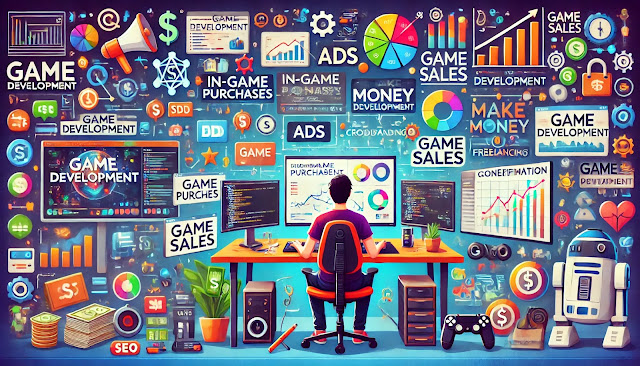How to Make Money with Game Development
How to Make Money with Game Development: A No-BS Guide
Let’s cut to the chase. You’re here because you want to make money with game development. Maybe you’re a solo developer, a small indie team, or just someone who loves games and wants to turn that passion into profit. But you’re probably wondering:
“Is it even possible to make money in such a crowded market?”
“Do I need a huge budget or a team of 50 people?”
“What if my game flops?”
I get it. The game industry is competitive, but it’s also one of the most lucrative creative fields out there. The key? Knowing how to play the game—both in development and in business.
In this guide, I’ll break down how to make money with game development without the fluff, the cringe, or the overhyped promises. Let’s dive in.
1. Start with a Marketable Idea (Not Just a “Cool” One)
Here’s the truth: Your game doesn’t have to be the next Fortnite or Minecraft to make money. But it does need to solve a problem or fill a gap in the market.
Research trends: Use platforms like Steam, itch.io, or App Annie to see what’s trending.
Identify your audience: Are you targeting hardcore gamers, casual mobile players, or niche communities like puzzle or horror fans?
Keep it simple: Your first game doesn’t need to be a 100-hour RPG. Start small, test the waters, and scale up.
Pro Tip: If you’re stuck for ideas, check out MillionFormula.com. They’ve got killer strategies for finding profitable niches in gaming and beyond.
2. Monetization Models That Actually Work
Making money with game development isn’t just about selling your game for $20. There are multiple ways to monetize, and the best approach depends on your game and audience.
A. Premium Pricing
Sell your game upfront (e.g.,
10−10-60).
Works best for PC/console games with a strong value proposition.
Example: Hades by Supergiant Games.
B. Free-to-Play (F2P) with In-App Purchases
Offer the game for free but monetize through skins, power-ups, or cosmetics.
Great for mobile games or multiplayer titles.
Example: Genshin Impact.
C. Subscriptions
Charge players monthly for access to exclusive content or features.
Ideal for MMOs or games with ongoing updates.
Example: World of Warcraft.
D. Ads
Integrate ads (banner, interstitial, or rewarded videos).
Best for casual mobile games.
Example: Candy Crush Saga.
E. Crowdfunding
Use platforms like Kickstarter or Indiegogo to fund your game before it’s finished.
Build a community early and get them invested in your success.
3. Build a Community Before You Launch
Your game won’t sell itself. You need an audience that’s hyped to play it. Here’s how to build that buzz:
Social Media: Post behind-the-scenes content, dev logs, and teasers on Twitter, TikTok, and Instagram.
Discord: Create a server to engage with your fans directly.
Early Access: Let players try your game before launch and give feedback.
Content Creators: Partner with streamers and YouTubers to showcase your game.
Pro Tip: The sooner you start building your community, the better. Even if your game is 6 months away, start posting now.
4. Distribution Platforms: Where to Publish Your Game
Where you publish your game can make or break your success. Here are the top platforms to consider:
Steam: The go-to for PC games.
itch.io: Great for indie and experimental games.
App Store & Google Play: Essential for mobile games.
Epic Games Store: Offers better revenue splits than Steam (88/12).
Console Stores: PlayStation, Xbox, and Nintendo Switch for console games.
5. Marketing on a Budget
You don’t need a million-dollar marketing budget to get noticed. Here’s how to market your game without breaking the bank:
Leverage Social Media: Post consistently and engage with your audience.
Create a Trailer: A 1-2 minute video showcasing your game’s best features.
Press Kits: Send press kits to gaming websites and journalists.
Cross-Promotions: Partner with other indie developers to promote each other’s games.
6. Post-Launch: Keep the Money Flowing
Your game’s launch is just the beginning. To keep making money, you need to keep players engaged.
Updates: Regularly add new content, levels, or features.
DLCs: Offer paid expansions or additional content.
Community Events: Host tournaments, challenges, or live streams.
Merchandise: Sell merch like T-shirts, posters, or collectibles.
FAQs About Making Money with Game Development
Q: Can I make money as a solo game developer?
A: Absolutely. Many indie developers start solo and scale up as their games gain traction.
Q: How much money can I make from game development?
A: It varies. Some indie games make a few hundred dollars, while others (like Among Us or Stardew Valley) generate millions.
Q: Do I need to know how to code?
A: Not necessarily. Tools like Unity, Unreal Engine, and GameMaker Studio make it easier for non-coders to create games.
Q: What’s the best way to learn game development?
A: Start with free resources like YouTube tutorials, or invest in courses on platforms like Udemy or Coursera.
Final Thoughts
Making money with game development isn’t easy, but it’s 100% possible if you’re willing to put in the work. Start with a marketable idea, choose the right monetization model, build a community, and market like crazy.
And if you’re looking for more ways to make money online, check out MillionFormula.com. They’ve got proven strategies for turning your skills into income, whether you’re into gaming, content creation, or entrepreneurship.
Remember, the game industry rewards creativity, persistence, and smart business decisions. So, what are you waiting for? Start building your game today.
Keyword: How to Make Money with Game Development


.webp)
Comments
Post a Comment